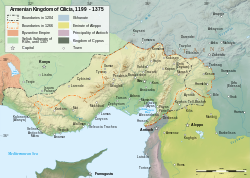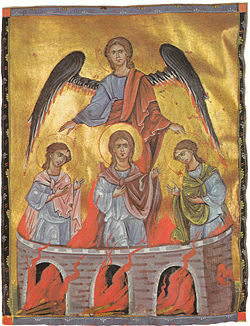Toros Roslin
Toros Roslin | |
|---|---|
Hethum I |
Toros Roslin (
The human figures in his illustrations are rendered full of life, representing different emotional states. Roslin's illustrations often occupy the entire surface of the manuscript page and at times only parts of it, in other cases they are incorporated in the texts in harmony with the ensemble of the decoration.[6]
Biography

Little is known about Toros Roslin's life. He worked at the scriptorium of
Only Armenians of noble origin had a surname in the Middle Ages; however, the surname of Roslin does not figure among the noble Armenian families.[10] Roslin may have been an offspring of one of the marriages common between Armenians and Franks (any person originating in Catholic western Europe) that were frequent among the nobility but occurred among the lower classes as well.[7] Roslin also names his brother Anton and asks the readers to recall the names of his teachers in their prayers.[7]

Levon Chookaszian proposed a more detailed explanation of the appearance of this surname in the Armenian milieu. He asserted that the surname Roslin originated from Henry Sinclair of the Clan Sinclair, baron of Roslin who accompanied Godfrey of Bouillon in the 1096 Crusade to Jerusalem. Chookaszian's hypothesis is based on the assumption that like most prominent Crusaders of the time,[11] Sinclair married an Armenian.[8]
The approximate dates of Roslin's birth and death can be determined using the dates of his manuscripts. Based on the following it can be assumed that Roslin was at least 30 in 1260.
Manuscripts

Signed by Toros Roslin
Seven manuscripts have been preserved that bear the signature of Roslin, they are made between 1256 and 1268 five of which are copied and illustrated by Roslin.
The Sebastia Gospel of 1262 (MS No. 539) is located in
Canon tables and ornaments
The principal innovation of Roslin in regards to ornaments within
Attributions

Several contemporary manuscripts from the 13th century, devoid of colophons have sometimes been attributed to Roslin.
The priest Hovhannes who salvaged the remains of the old manuscript reports in one of the colophons that he had suffered seeing the old manuscript fall into the hands of the "infidels" like "a lamb delivered to wolves" and that he renovated it so that the "royal memorial written in it might not be lost". Part of the original colophons, the "royal memorial" reports that the manuscript was written in the see of Hromkla in 1266 for the king Hethum. The uncials are identical to that of MS 539 and similar marginal ornaments adorn both.
Iconography
Among Roslin's various miniatures on the
Legacy
Sirarpie Der-Nersessian devoted the longest chapter in her posthumously published magnum opus Miniature Painting in the Armenian Kingdom of Cilicia to Toros Roslin whose work she had researched for years. In the chapter she underlines: "Roslin's ability to convey deep emotion without undue emphasis," and in describing one of Roslin's scenes she extols: "The compositional design, the delicate modeling of the individual figures, and the subtle color harmonies show Roslin’s work at its best, equaling in artistic quality some of the finest Byzantine miniatures."[34]
A 3.4 meter high statue of Toros Roslin made of basalt was erected in 1967 in front of the entrance of Matenadaran. The statue was designed by Mark Grigoryan and sculpted by Arsham Shahinyan.[35] A fine arts academy named after Toros Roslin was founded in 1981 by the Hamazkayin Armenian Educational and Cultural Association in Beirut, Lebanon.[36]
See also
Gallery of his work
- Sample of creations
-
John the Apostle, Malatia Gospel of 1268 (MS No. 10675)
-
Beginning of theGospel of St. Mark, Zeytun Gospel of 1256 (MS No. 10450)
-
ThePassage of the Red Sea, Mashtots, 1266 (MS No. 2027)
-
TheLast Judgement, Toros Roslin Gospels of 1262 (MS 539)
-
Ancestors of Christ, Toros Roslin, 1262
-
Gospel of Malatia, 1268 (Ms. 10675)
-
Saint Luke the Evangelist
-
The Incredulity of St. Thomas, Malatia Gospel, 1267-1268 (MS No. 10675)
-
The Portrait of Prince Levon, 1250 (Ms. 8321)
-
Evangelist Matthew Seated Dipping Pen in Inkwell, 1262
-
Canon Table Page
-
portrait of King Levon and Queen Keran, 1262 (Ms. 2660)
-
The Resurrection of Lazarus (Ms. 9422)
Notes
- ^ The period between 1210 and 1270 is the estimated lifespan of Roslin according to Professor Levon Chookaszian. See: Chookaszian, Levon. "Toros Roslin: Biography". Armenian Studies Program, California State University. Archived from the original on 2008-10-06. Retrieved 2008-07-26.
- ^ a b c Parry, 399
- ^ Chookaszian, Levon. "Toros Roslin: New themes". Armenian Studies Program, California State University. Archived from the original on 2011-08-20. Retrieved 2008-07-26.
- ^ Chookaszian, Levon. "Toros Roslin: Royal portraits". Armenian Studies Program, California State University. Archived from the original on 2011-08-20. Retrieved 2008-07-26.
- ^ Kouymjian, Dickran. "Arts of Armenia [Miniatures]". Armenian Studies Program, California State University. Archived from the original on 2008-09-15. Retrieved 2008-08-07.
- ^ Hakopyan, Hravard; Korkhmazian, Emma. "THE SCHOOL OF MINIATURE PAINTING OF THE CILICIAN ARMENIAN KINGDOM". Virtual Matenadaran. Archived from the original on November 30, 2007. Retrieved 2008-08-06.
- ^ a b c d Der Nersessian, 51
- ^ a b Chookaszian, Levon. "Toros Roslin: Biography". Armenian Studies Program, California State University. Archived from the original on 2008-10-06. Retrieved 2008-07-26.
- ^ a b Azarian, 323
- ^ Professor Charles Dowsett pointed to similarities with the Middle High German word roeslin meaning small rose. See: "Quelques ouvrages récents sur l'art médiéval arménien". Cahiers de civilisation médiévale. 16: 218. 1973.
- Baldwin of Bourcq married Morphia of Melitene, Joscelin Imarried Beatrice etc. See: Sirarpie, Der Nersessian (1977). L'Art Armenien des origines au XVIIe siecle (in French). Paris: Arts et Methiers Graphiques. p. 135.
- .
- ^ Azarian, 329
- ^ Der Nersessian, Sirarpie (1963). "Armenian Manuscripts in the Freer Gallery of Art". Oriental Studies. 6. Smithsonian Institution: 90.
- ^ Azarian, 322
- ^ a b Der Nersessian, 52
- ISBN 0-520-09505-7.
- ^ The amount of work it took to copy and illustrate the Sebastia gospel which was completed in the same year is probably the reason why the copying of the manuscript was assigned to the scribe Avetis. Der Nersessian, 52
- ^ a b Der Nersessian, 53
- ^ Johnston, 203
- ^ [1] Archived June 6, 2010, at the Wayback Machine
- ^ Der Nersessian, 53-54
- ^ Hazard, 137
- ^ a b Der Nersessian, 75
- ^ Der Nersessian, 64
- ^ Der Nersessian, 65
- ^ Der Nersessian, 76
- ^ Der Nersessian, 54
- ^ Der Nersessian, 55
- ^ Der Nersessian, 55-56
- ^ Der Nersessian, 56
- ^ Chookaszian, Levon. "Toros Roslin: Iconography - Nativity". Armenian Studies Program, California State University. Archived from the original on 2008-10-06. Retrieved 2008-09-27.
- JSTOR 3591390.
- ISBN 0-299-20750-1.
- ^ Khanjyan, 118
- ^ "Hamazkayin in lebanon". Hamazkayin. Archived from the original on 2011-07-21. Retrieved 2008-08-06.
References
- Der Nersessian, Sirarpie (1993). Miniature Painting in the Armenian Kingdom of Cilicia from the Twelfth to the Fourteenth Century. Dumbarton Oaks. p. 620. ISBN 0-88402-202-1.
- Azarian, Levon; et al. (1976). Prominent Figures of Armenian Culture, 5th-18th Centuries ("ՀԱՅ ՄՇԱԿՈՒՅԹԻ ՆՇԱՆԱՎՈՐ ԳՈՐԾԻՉՆԵՐԸ, V - XVIII ԴԱՐԵՐ") (in Armenian). Yerevan State University Publishing. p. 578.
- Parry, Ken (July 20, 2007). The Blackwell Companion to Eastern Christianity (1 ed.). Wiley-Blackwell. p. 528. ISBN 978-0-631-23423-4.
- Bedrosian, Margaret (1992). The Magical Pine Ring: Culture and the Imagination in Armenian-American Literature. Wayne State University Press. p. 249. ISBN 0-8143-2339-1.
- Khanjyan, Artush (2004). The Monuments of Yerevan. VMV-Print. p. 144. ISBN 99941-920-1-9.
- Hazard, Harry W.; Setton, Kenneth M. (September 15, 1977). "III: Ecclesiastical Art in the Crusader States in Palestine and Syria". A History of the Crusades, Volume IV: The Art and Architecture of the Crusader States (1st ed.). University of Wisconsin Press. p. 448. ISBN 0-299-06820-X.
- R. Johnston, William (1999). William and Henry Walters: The Reticent Collectors. Baltimore, MD: JHU Press. p. 309. ISBN 0-8018-6040-7.
Further reading
- Drampian, Irina (2000). Toros Roslin. Yerevan: Tigran Metz Publishing House. p. 300.













